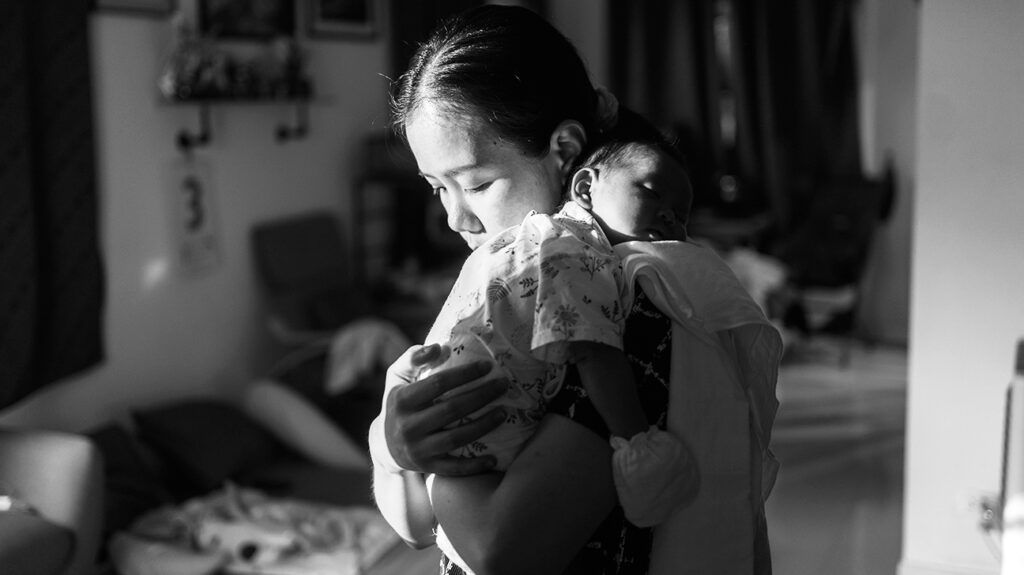People with postpartum bipolar disorder have severe high and low shifts in their mood after giving birth. Pregnancy can increase the risk of complications with bipolar disorder.
Bipolar disorder (BD) is a mental health condition. It causes atypical shifts in mood, energy, and concentration that can affect a person’s daily life.
There are several BD types. If a person receives a BD diagnosis in the recovery period after giving birth, this is known as postpartum bipolar disorder (PPBD).
Pregnancy may worsen a person’s BD symptoms and increase their risk of some complications. However, several treatments can help manage PPBD.
This article discusses what causes postpartum bipolar disorder, PPBD versus postpartum depression, and whether PPBD can lead to bipolar disorder. It also discusses PPBD symptoms and treatments.

If a person receives a diagnosis of bipolar disorder in the recovery period after pregnancy, this is known as postpartum bipolar disorder.
People with BD have a
Researchers do not currently know
- issues with the brain’s:
- chemistry
- structure
- functioning
- issues with a person’s genetics
People with BD often develop it in their mid-20s. They may have several episodes of symptoms that come and go over months or years. This can lead to people having BD episodes at the same time as multiple pregnancies and childbirth.
A pregnant person
Postpartum depression
Many pregnant people feel sad, worried, or tired within a few days of giving birth. For some, these feelings go away in a few days.
A person may have postpartum depression (PPD) if they feel sad, hopeless, or anxious for longer than
These feelings may be mild to severe and can interfere with a person’s daily life. About
PPD is a serious mental health condition. It may affect a person’s parenting ability and development of the baby. However, there are effective treatments available. If a person is experiencing symptoms of PPD, they need to speak with a healthcare professional.
Learn more about postpartum depression.
Postpartum bipolar disorder
According to 2017 research, 21.4% to 54% of women with PPD may also have BD. Many individuals who receive a diagnosis of PPD may actually have BD instead.
Pregnant people with BD may
Which is more severe?
People with PPBD may have a
- hallucinations
- delusions
- confusion
A person with PPBD may also have a
Can postpartum depression lead to bipolar disorder?
Having a history of PPD
Symptoms of PPBD
Symptoms of manic episodes may include:
- feeling very joyful or extremely irritable or touchy
- feeling more active than usual or jumpy
- needing less sleeptalking fast about many things
- racing thoughts
- feeling able to do many things at once without becoming tired
- having an excessive appetite for activities such as food, drink, or intercourse
- feeling unusually powerful, talented, or important
Symptoms of depressive episodes may include:
- feeling very down, sad, or anxious
- feeling slowed down or restless
- having difficulty getting or waking up from sleep
- sleeping a lot
- talking very slowly
- feeling unable to find anything to say
- forgetfulness
- trouble concentrating or making decisions
- feeling unable to do simple things
- having a lack of interest in nearly all activities
- feelings of hopelessness or worthlessness
- suicidal thoughts
Help is out there
If you or someone you know is in crisis and considering suicide or self-harm, please seek support:
- Call or text the 988 Lifeline at 988 or chat at 988lifeline.org. Caring counselors are available to listen and provide free and confidential support 24/7.
- Text HOME to the Crisis Text Line at 741741 to connect with a volunteer crisis counselor for free and confidential support 24/7.
- Not in the United States? Find a helpline in your country with Befrienders Worldwide.
- Call 911 or your local emergency services number if you feel safe to do so.
If you’re calling on behalf of someone else, stay with them until help arrives. You may remove weapons or substances that can cause harm if you can do so safely.
If you’re not in the same household, stay on the phone with them until help arrives.
A person may also have episodes of mixed symptoms. People with some forms of BD may have hypomania, a less severe form of manic episodes.
Although people with PPBD can have both high and low episodes,
A pregnant person with BD may also experience more severe BD symptoms. These can lead to an
Learn more about common symptoms of bipolar disorder.
Treatment options for PPBD can help people to have fewer mood episodes. They
- psychotherapy
- electroconvulsive therapy
- care in a healthcare facility
They also include medication, including:
However, some PPBD medications are not safe for a pregnant person. A person who is pregnant and has BD needs to discuss treatment options with a healthcare professional.
Learn more about treatments for bipolar disorder.
The following are answers to some questions people frequently ask about postpartum bipolar disorder.
What is postpartum mania?
Postpartum mania is when a person experiences periods of feeling overactive, restlessness, or uninhibited during the period after giving birth. People with BD may have a higher risk of having postpartum mania episodes.
What age does bipolar start in females?
The average age for the onset of BD in most people is 25 years old.
Bipolar disorder resources
Visit our dedicated hub for more research-backed information and in-depth resources on bipolar disorder.
People with postpartum bipolar disorder (PPBD) experience new or worsened bipolar disorder symptoms in the period after giving birth. They generally have episodes of very high and very low moods that can severely affect their daily life.
Researchers do not currently know the exact cause of PPBD. However, there are effective treatments to help a person with PPBD experience fewer mood episodes and manage the condition.

